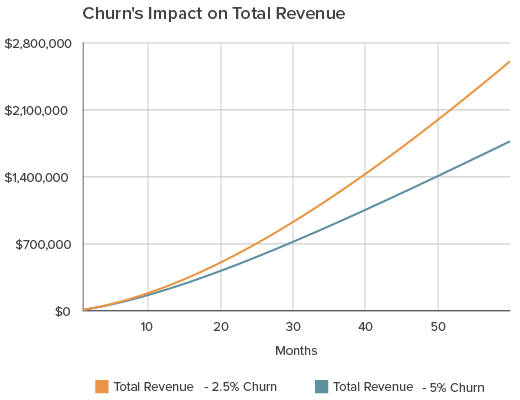Churn has a huge impact on your business. Did you know that your business could have 50% more revenue if you cut its churn in half? It’s true–check out the spreadsheet if you don’t believe me.
After 5 years, a company with 2.5% churn is 50% larger than the company with 5% churn on a revenue basis. And as the company ages, the effect becomes even more significant.

Don’t wait until after a customer has churned to do damage control. Here are our favorite tips to proactively prevent churn.
Set up a reasonable schedule to email your customers
The keyword here is reasonable. How often do you your customers normally make a purchase? If they only purchase once per quarter, sending out a daily email might annoy customers, not encourage them to buy more! To determine your schedule, test several schedules and measure the impact of email frequency on unsubscribe rates and repeat purchase rates.
Once you’ve determined a reasonable schedule, think about how you can personalize those emails as much as possible. This can be as easy as setting up sales alerts for products they viewed but not purchased or as in depth as hundreds of automated, targeted marketing emails based on customer behaviour.
Engage your customers through social media
No, we mean really engage customers through social media. Enough with the Facebook posts asking customers to do all the work for you. Get out there, find out where your fans are and do the work for them! Are people posting photos of your products on Instagram? Ask if you can highlight them on your site. Clothing retailers can follow on tweets about purchases by asking how the customer wore the item, or where they wore it. Think of social media not as a way to broadcast your message, but as a way to make as many best friends as possible. This is a high touch effort that can yield incredible results. Check out any product on the Free People website and their Twitter page for an amazing example of this.
Reward customers for loyalty
Make it known up front that you reward loyalty. Then, try to reward loyalty with every single purchase. The more customers know they will be rewarded, they less likely they will be to go somewhere else. Amazon does this in an interesting way with it’s subscribe and save feature. They take a single purchase and turn it into a subscription.
Ask what went wrong
Not every customer will be the best customer and that’s ok. Once a customer has churned, send them an email asking what went wrong. Make it easy for customers to share their experience in their own words — forget trying to fit them into a drop down menu — and try not to make it feel personal. While most of the emails will go unanswered, you should get some replies back, especially if a customer had a bad experience. If you start to notice a trend, you should have some pretty actionable data on what to do to fix that poor customer experience.
These tips are just a starting point to work on decreasing your churn rate. However, you won’t be able to effectively decrease it if you aren’t measuring it properly in the first place. Read our Churn Rate 101 white paper to learn all the basics of churn, how to measure it and how it affects your business.

